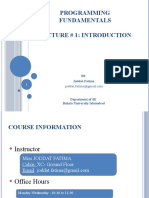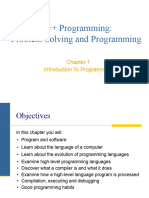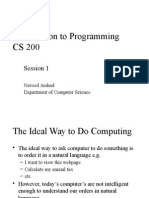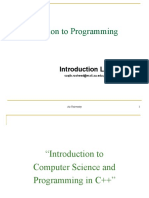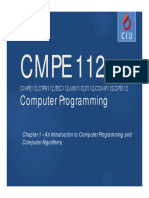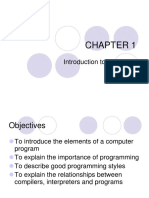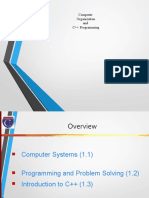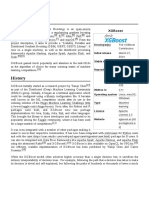CHAPTER: 1
Summary and Key Notes
Introduction
• What is Programming: A precise sequence of steps to solve a particular
problem.
• Importance of Programming: Develops analytical and problem-solving
abilities.
• Skills Needed: Attention to detail,reusability,user interface design,
understanding that computers are literal, and liberal code commenting.
What is Programming?
• Definition: A program is a sequence of steps to solve a problem.
• Purpose: To perform activities in a specific order to solve a given problem.
Why Programming is Important
• Develops Skills: Problem analysis, critical thinking, and analytical thinking.
• Application: Useful for various professions, not just programming.
What Skills are Needed
• Attention to Detail: Analyze the problem carefully.
• Reusability: Write code that can be reused
• User Interface: Assume users are not computer literate.
• Computers are Literal: Instructions must be explicit.
• Commenting Code: Helps in understanding the code.
Basic Recipe for Writing Programs
1. Analyze the Problem Statement: Understand the problem fully.
2. Express the Essence: Abstractly and with examples.
3. Formulate Statements: Use precise language.
4. Evaluate and Revise: Based on checks and tests.
5. Pay Attention to Detail: Crucial for successful programs.
Example: Calculator Program
• Variables: Store data.
• Cin Statement: Input from the user.
1
� CHAPTER: 1
• Cout Statement: Output to the user.
• Operators: Use arithmetic operators(D,M,A,S).
Points to Remember
• User-Friendly Interface: Do not assume user knowledge.
• Commenting: Essential for code readability.
• Attention to Detail: Critical for successful programs.
• Programming Process: Involves design and development, not just coding.
High-Level vs Low-Level Languages
• High-Level Languages: Easier to understand and write.
• Low-Level Languages: Closer to machine code, harder to understand.
Compiler vs Interpreter
• Compiler: Translates the entire program before execution.
• Interpreter: Translates and executes the program line by line.
C++Programming Language
• Overview:Cross-platform,high-performance,object-oriented.
• Features: Control over system resources,memory,portability.
• Applications: Operating systems,GUIs,embedded systems.
Structure of a C++Program
• Components:
Variables, data types, arithmetic operators, precedence of operators.
Sample Program
#include<iostream.h>
Main() {
Cout << “Hello World”;
Key Points:
• `#include`:Pre-processor directive to include files.
2
� CHAPTER: 1
• `main()`:Entry point of the program.
• `cout`:Output stream.
• `;`:Ends statements.
Data Types for Whole Numbers
• int: Stores whole numbers,4 bytes.
• short: Smaller range,2 bytes.
• long: Larger range,8 bytes.
Data Types for Real Numbers
• float: Stores real numbers,4 bytes.
• double: Larger real numbers,8 bytes.
Char Data Types
• char: Stores single characters,1 byte.
Notes for Exam
1. Understand the Definition of Programming: A sequence of steps to
solve a problem.
2. Importance of Programming: Develops analytical and problem-solving
skills.
3. Skills Needed: Attention to detail,reusability,user-friendly interfaces,
understanding computers are literal, and commenting code.
4. Basic Recipe for Writing
Programs:Analyze,express,formulate,evaluate,and pay attention to
details
5. Example Program: Understand variables,cin,cout,and operators.
6. Points to Remember: User-friendly interface,commenting,attention to
detail.
7. High-Level vs Low-Level Languages: Understand the differences.
8. Compiler vs Interpreter: Know the translation process.
9. C++Overview:Cross-platform,high-performance,object-oriented.
10. Structure of a C++Program:Variables,data types, operators.
11. Sample Program: Understand the components and syntax.
12. Data Types: Know the differences between
int,short,long,float,double,and char.

